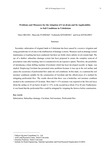Problems and Measures for the Adoption of Cut-drain and Its Applicability to Soil Conditions in Uzbekistan
JIRCAS Working Report
| ISSN | 1341710X |
|---|---|
| NII recode ID (NCID) | AA11159468 |

Full text
jircas_working_report88-_75-90.pdf715.63 KB
Secondary salinization of irrigated lands in Uzbekistan has been caused by excessive irrigation and rising groundwater levels due to the malfunction of drainage systems. Measures such as drainage system maintenance or leaching has been conducted, but there are fields where salinity levels remain high. The use of a shallow subsurface drainage system has been proposed to ensure the complete removal of percolation water after leaching, but it is considered to be an expensive option. Therefore, the possibility of introducing a drain drilling machine (Cut-drain) which has been developed recently in Japan, was studied. Employing Cut-drain has presented some problems because it rises up to the soil surface and causes the occurrence of preferential flow under dry soil conditions. In this study, we examined the soil moisture conditions suitable for the construction of Cut-drain and the effectiveness of a method for mitigating preferential flow. The results showed that there was a borderline soil moisture condition needed in the construction of Cut-drain. More than 9–11% moisture was required in the first soil layer (from the surface to 20 cm below it) and 12–15%, in the second layer (from 20 to 40 cm). Furthermore, it was found that the preferential flow could be mitigated by irrigating the furrows before construction.
| Date of issued | |
|---|---|
| Creator | Yukio OKUDA Haruyuki FUJIMAKI Yoshinobu KITAMURA Iwao KITAGAWA |
| Subject | Salinization Subsurface drainage Cut-drain Soil moisture Preferential flow |
| Volume | 88 |
| spage | 75 |
| epage | 90 |
| Relation | isPartOf : JIRCAS Working Report no.88 |
| Language | eng |
Related Publication
isPartOf
